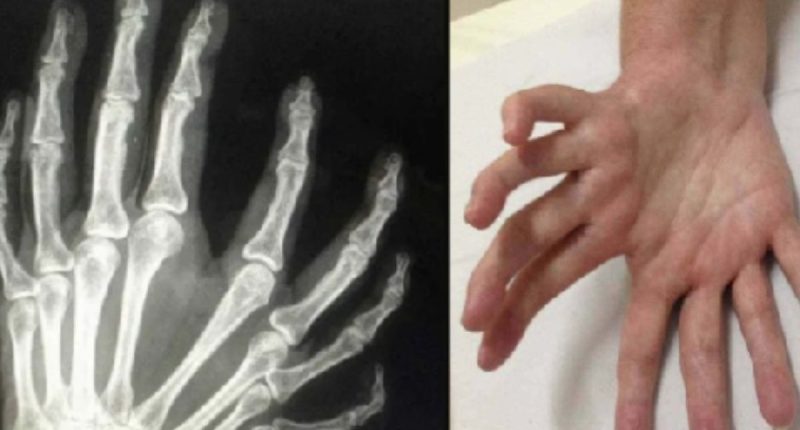Mirror hand syndrome, also known as ulnar dimelia, is a very rare congenital birth defect that affects the hands. It essentially means a person is born with one or both hands having mirror-image duplication of fingers and bones. Here’s a breakdown of the key aspects:
People with mirror hand syndrome typically have 7 to 10 fingers on one or both hands. These fingers often mirror each other, meaning a central finger flanked by three fingers on either side, resembling a reflection in the middle.
The bones behind the extra fingers, including carpal bones (wrist), metacarpal bones (palm), and phalanges (fingers), are also duplicated.
The affected arm may have limited range of motion or other structural abnormalities in the upper limb.
Causes
While the exact cause remains a mystery, scientists have identified several potential factors that may contribute to its development. Let’s delve into these possibilities with a mindful approach, focusing on scientific understanding and respecting the experiences of individuals affected by this condition.
Disruptions in Signaling Molecules – During early embryonic development, signaling molecules like Sonic hedgehog play a crucial role in guiding limb formation. Disruptions in this delicate signaling process can lead to malformations like mirror hand syndrome. Imagine these molecules as tiny messengers orchestrating the intricate dance of cell differentiation and tissue patterning. When their communication gets scrambled, unexpected structures like extra fingers can appear.
Gene Mutations – Specific genes like DCC and RAD51 are involved in limb development and neuronal guidance. Mutations in these genes can alter the blueprint for hand formation, potentially leading to mirror hand syndrome. Think of genes as the instruction manuals for building an organism. Faulty instructions can lead to incorrect parts or unexpected assemblies, like the mirrored fingers seen in this condition.
Environmental Factors – While the primary cause of mirror hand syndrome is thought to be genetic or developmental, certain environmental factors like exposure to certain chemicals or maternal illness during pregnancy might play a role. Imagine the delicate process of limb development as a fragile ecosystem. External disturbances, though not the sole cause, can sometimes tip the balance towards malformations.
Complex interplay – It’s important to remember that mirror hand syndrome likely arises from a complex interplay of various factors, not just a single, simple cause. Genes, signaling molecules, and environmental influences all likely contribute in a intricate dance that we’re still trying to understand. Think of it as a intricate puzzle with many missing pieces, each piece adding to the bigger picture.
Exploring further – While a definitive answer to the cause of mirror hand syndrome remains elusive, ongoing research continues to shed light on this fascinating condition. By studying cell and molecular biology, genetics, and developmental processes, scientists are piecing together the puzzle, paving the way for better understanding, diagnosis, and potential treatments in the future.
While the exact cause remains a mystery, understanding the symptoms and signs can help with early diagnosis and provide valuable information for managing the condition.
Key Signs/Symptoms
-
Extra fingers: Individuals with mirror hand syndrome typically have 7 to 10 fingers on one or both hands. These fingers often mirror each other, resembling a reflection in the middle, with a central finger flanked by three fingers on either side.
-
Duplicated bones: The bones behind the extra fingers, including carpal bones (wrist), metacarpal bones (palm), and phalanges (fingers), are also duplicated. This can lead to a wider and thicker hand appearance.
-
Limited range of motion: Affected hands may have limited mobility due to the presence of extra fingers and structural abnormalities. This can make it challenging to perform tasks requiring fine motor skills.
-
Other anomalies: In some cases, the affected arm may be shorter or have other structural differences compared to the unaffected arm.
Additional Symptoms:
- Difficulty grasping and manipulating objects
- Pain or discomfort in the affected hand
- Challenges with writing and typing
- Social and emotional challenges due to the visible difference in the hands
Implication
Physical Implications:
- Functional challenges: Extra fingers and duplicated bones can limit hand mobility and fine motor skills, impacting daily activities like grasping, writing, and typing.
- Pain and discomfort: The additional structures may cause discomfort or pain, especially during growth and development.
- Risk of complications: Surgical interventions to reshape or remove fingers carry potential risks like infection, nerve damage, and scar tissue formation.
Social and Emotional Implications:
- Social stigma: The visible difference in hand appearance can lead to stares, questions, and even bullying, potentially impacting self-esteem and social interactions.
- Emotional challenges: Adapting to life with mirror hand syndrome can be emotionally difficult, leading to feelings of anxiety, isolation, and frustration.
- Body image concerns: The atypical hand appearance can negatively affect body image and self-confidence.
Familial Implications:
- Support network: Family members play a crucial role in providing emotional, practical, and financial support to individuals with mirror hand syndrome.
- Learning and adjustment: Families may need to adjust routines and daily activities to accommodate the limitations and specific needs of the affected individual.
- Connecting with resources: Navigating medical treatments, therapies, and support groups can be challenging, and families may need guidance and assistance.
In conclusion, mirror hand syndrome presents a unique set of challenges, but it’s important to remember that individuals and families can thrive with adequate support, understanding, and access to resources. By focusing on individual needs and fostering a supportive environment, we can ensure that people with mirror hand syndrome can lead fulfilling lives.
It’s crucial to acknowledge and address the potential sensitivities surrounding this topic while providing accurate and helpful information. Remember, respect, empathy, and a focus on individual well-being are key when considering the implications of mirror hand syndrome.
Research
Scientists are actively researching the causes and potential treatments for mirror hand syndrome. This research delves into Identifying genes linked to the condition can unlock avenues for genetic testing and counseling. Understanding the intricate process of limb formation during embryonic development can lead to insights into why disruptions occur in mirror hand syndrome. Researching and refining surgical procedures for reconstructing hands affected by mirror hand syndrome can improve functionality and aesthetics.
ALSO READ:
- Final Stages of Mantle Cell Lymphoma: Prognosis, Treatment Options, and Support
- Thyroid condition: disorders, causes, symptoms, diagnosis and treatment
- Are Tongue Ulcers Contagious And Harmful?
Additional Resources
https://jnnp.bmj.com/content/jnnp/44/7/586.full.pdf
https://jmg.bmj.com/content/jmedgenet/33/5/426.full.pdf
https://www.surgjournal.com/article/S0039-6060(20)30857-6/fulltext









